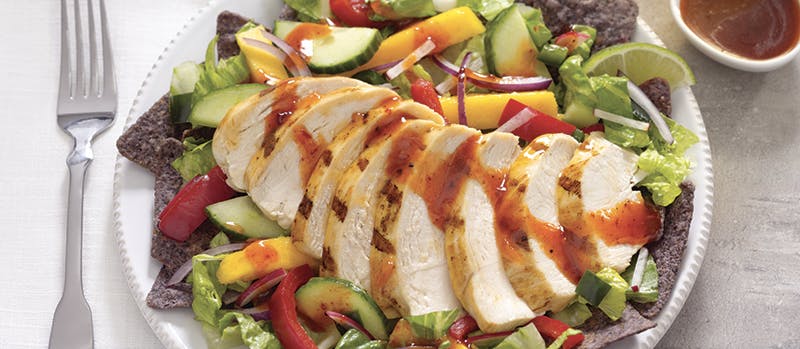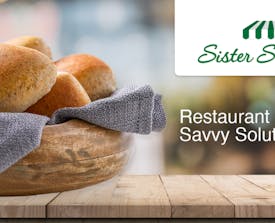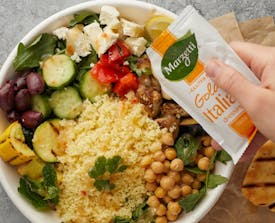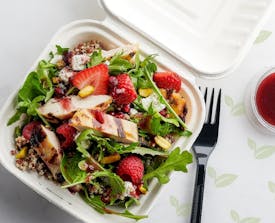
Feature Clean-Label Ingredients To Drive Salad Sales

Consumers want more healthful menu items and real ingredients
The clean-label trend is booming right now, as consumers opt for foods that contain no artificial colors, flavorings or preservatives. The evolving better-for-you dietary scene also encompasses the growing popularity of plant-based, organic and gluten-free foods. Not surprisingly, few menu items suggest healthful eating more than salads, and operators who emphasize clean-label ingredients have the opportunity to make these leafy greens even more appealing while they drive sales.
According to the IFIC Foundation’s 2019 Food and Health Survey, when asked whether they followed any specific diet or eating pattern over the past year, 38 percent of those individuals polled replied “yes,” up from 36 percent in 2018. The survey also found that “clean eating” ranked as the most widely cited diet at 10 percent, followed by intermittent fasting at 9 percent and then gluten-free and low-carb, both at 6 percent.
The Challenge
Fresh, colorful salads can be the perfect menu option for today's health-minded consumers, but operators must make sure every ingredient fits the no-chemicals definition.
“The biggest clean-label challenges when it comes to salads are the dressings, protein and crunchy toppings like croutons,” says Amy Myrdal Miller, president of Farmer’s Daughter Consulting in Carmichael, California. “Of these three, protein is the biggest challenge. Watch out for sodium-pumped poultry, nitrates in bacon, antibiotics in frozen shrimp or coatings and batters on fried chicken.”
But salad dressings can also present the same sort of challenge whether the dressing is added by the guest, or the kitchen or service staff. Consumers want to know what is in the dressing, so one solution is to offer it in individual packages, with the ingredients printed on the label. These single-serve containers also address another important trend — customization. Diners can add as much or as little dressing as they choose.
Announce the Clean Label
Manufacturers recognize the importance of calling attention to the all-natural and chemical-free attributes of foods. According to Innova Market Insights, 28 percent of global food and beverage launches in 2018 featured one or more clean-label claims, such as natural, organic, no additives/preservatives and GMO-free. In the U.S., the rate was higher at 39 percent of all launches. Innova also points out that the most common attribute is no additives or preservatives, with 20 percent of new product launches in the U.S. making that claim.
Foodservice operators employ menus, salad bar signage, social media and other messaging to emphasize their clean-label offerings.
“Consumers may not see package labels to determine if they can recognize every ingredient, but there are keywords that give the impression of clean, including fresh, local, housemade, artisan and hand-crafted,” Myrdal Miller says. “Play up what you make in house, what’s sourced locally and what you’re most proud of, and your salad program will do well.”
Stick with Favorites
Diners want clean-label versions of their favorite foods, including dressings. Ranch dressing is always popular, so much so that 44 percent of all consumers polled eat it at least once a week, according to Datassential’s February 2019 Foodbytes: Condiments, Sauces & Dressings Keynote Report. In addition, Datassential found that 59 percent of consumers polled say they would be more likely to buy — or even pay more — for clean-label salad dressings.
Ranch is one of several flavors in the Marzetti® Simply Dressed® line of clean-label dressings. Guests do not have to sacrifice flavor with Simply Dressed dressings. They are consumers’ number one choice for great taste, according to a test comparing Simple Dressed Italian and Caesar dressings to Ken’s Essentials, conducted by Spencer Research. The dressings contain no high-fructose corn syrup, preservatives, artificial flavors and soybean oil. They are also gluten-free. In addition to the 32-ounce bottles and back-of-the-house gallons, the dressings are also available in single-serve packets and cups. The flavor lineup includes:
- Blue Cheese
- Italian Vinaigrette
- Caesar
- Ranch
- Honey Mustard
- Balsamic Vinaigrette
Try it for free here.
Whether it’s a premium leafy green bowl from the trendiest restaurant concept or a simple fresh salad to complement other menu items, salads can present the quintessential clean-label offering. If the salad dressing also contains no artificial ingredients, that can make the menu item even more appealing to health-minded consumers and a solid traffic builder for savvy foodservice operators.
Related Trends
-

Restaurant Labor Woes, Savvy Solutions
The restaurant industry has long faced workforce challenges. But the current labor shortage is particularly difficult.
Read Article -

Beyond Lettuce: How Salads Mean So Much More Today
Salads have evolved beyond just a plate of lettuce into warm salads, grain bowls and so much more.
Read Article -

Boosting Off-Premise Sales
Operators can fill demand for healthful, off-premise meals and snacks with salads, grain bowls and other foods that go better with dressings and dips.
Read Article
